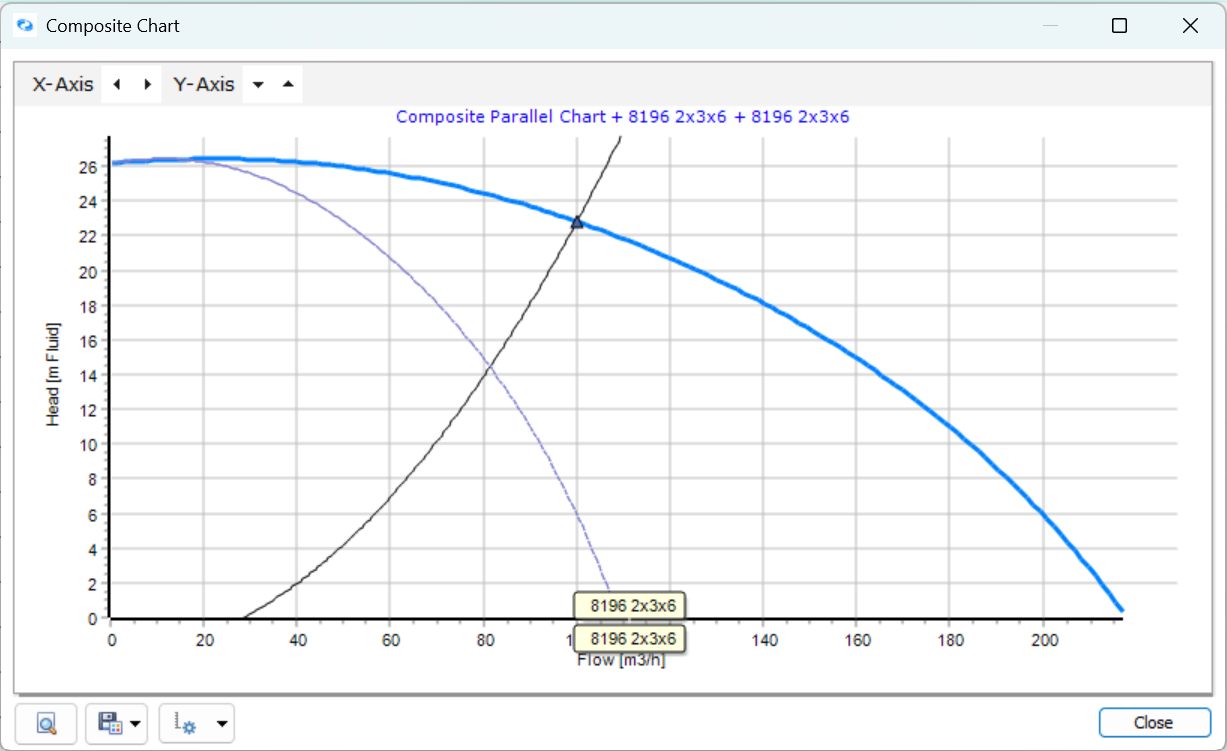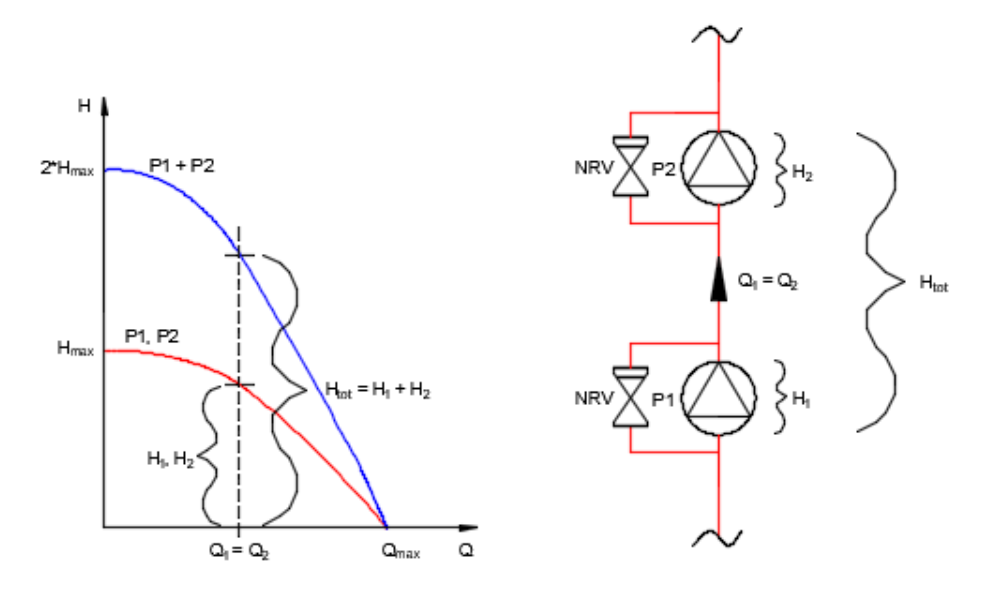Introduction
Pumps are often configured in parallel or series to meet specific flow and head requirements in fluid systems. Understanding how these configurations affect system performance is essential for efficient design in FluidFlow.
Parallel configurations are commonly used for systems with varying flow demands, while series configurations are preferred for overcoming high static or total heads. In both cases, FluidFlow allows you to plot composite pump curves to optimize performance and prevent inefficiencies.
Pumps in Parallel
Concept Overview
Pumps in parallel are installed to handle considerable variations in flow or variable flow requirements. The flexibility to switch pumps on or off makes them ideal for systems with fluctuating demand.
- Typically, parallel pumps are of similar type and size.
- They may also be of different sizes or speed-controlled, resulting in different pump performance curves.
Performance Characteristics
The total system performance curve for similar pumps in parallel is determined by adding the flow rates (Q1 + Q2) at each head value (H), where H1 = H2.

Figure 1: Similar Pumps in Parallel.
For identical pumps:
- Maximum head (Hmax) remains unchanged.
- Maximum flow (Qmax) doubles compared to a single pump.
Non-return valves are typically installed downstream of each pump to prevent bypass circulation when a pump is not running.
Applications & Advantages
Common Uses for Parallel Pump Systems:
- Municipal water supply networks and distribution systems
- Commercial building HVAC and water circulation
- Industrial cooling processes and heat exchange systems
- Irrigation networks with seasonal demand variations
Key Advantages of Parallel Operation:
- Enhanced system reliability through redundancy (N+1 configuration)
- Improved energy efficiency by maintaining operation near BEP (Best Efficiency Point)
- Reduced operational costs through selective pump activation based on demand
- Lower initial capital investment compared to a single large pump installation
- Extended equipment life through load sharing and reduced cycling frequency
Modeling in FluidFlow
To create a composite pump chart for parallel pumps in FluidFlow:
- Build your model with the pumps configured in parallel.
- Go to Tools | Composite Chart….
- Click the Parallel and Series Pumping tab.
- Choose Parallel Combination.
- Select the pumps you wish to include in the analysis (ensure they are set to "On").
- Click Plot to generate the composite chart.

Figure 2. Composite Performance Curves for Similar Pumps in Parallel.
Dissimilar Pumps in Parallel
Although parallel pumps are typically identical, dissimilar pumps can be used in certain applications:
- System expansions where original pump models may no longer be available.
- Renovated or partially upgraded systems.
- Systems with pumps that have different impeller diameters.
When dissimilar pumps operate in parallel, the combined performance curve is not smooth due to the way it is generated as the graphical sum of the individual pump curves.
Nonetheless, FluidFlow can plot composite curves for any combination of pumps, enabling accurate performance predictions even with mixed pump sizes.

Figure 3: Composite Performance Curves for Dissimilar Pumps in Parallel.
Pumps in Series
Concept Overview
Pumps in series are used when fluids must be transported over long distances or against high heads that exceed a single pump's capability.
Examples include:
- Pumping tailings.
- Power station ash transport.
- Underground fill.
- Concentrate pumping.
- High-rise building water supply.
Performance Characteristics
For series pumps, total head at a given flow rate is found by adding the heads of individual pumps vertically.

Figure 4: Pumps in Series.
For identical pumps in series:
- Maximum flow (Qmax) remains unchanged.
- Maximum head (Hmax) doubles compared to a single pump.
In cases where one pump is not operational, it creates resistance to flow. A bypass with a non-return valve can be installed to mitigate this.
Applications & Advantages
Common Uses for Series Pump Systems:
- Multi-stage booster pumps for high-rise buildings
- Deep well installations
- Mining applications with high static head
- Long-distance pipeline transport
Key Advantages of Series Operation:
- Enables pumping against higher discharge heads than a single pump can achieve
- Allows for overcoming significant elevation changes or pressure requirements
- Can be more economical than a single large pump in certain applications
- Provides flexibility to overcome varying system resistances
Modeling in FluidFlow
To create a composite pump chart for series pumps in FluidFlow:
- Build your model with the pumps configured in series.
- Go to Tools | Composite Chart….
- Click the Parallel and Series Pumping tab.
- Choose Series Combination.
- Select the pumps you wish to include in the analysis (ensure they are set to "On").
- Click Plot to generate the composite chart.

Figure 5. Composite Performance Curves for Similar Pumps in Series.
Best Practices
- Install non-return valves downstream of each pump in parallel setups to prevent backflow.
- Employ variable speed control for at least one parallel pump for optimal efficiency.
- Match pump characteristics closely when possible to avoid uneven load distribution.
- Avoid running one pump at very low efficiency due to mismatched curves in parallel systems.
- Do not operate series pumps without proper bypass arrangements when a pump is offline.
- Confirm pump operational status is set to "On" before generating composite curves in FluidFlow.
- Always include the system curve alongside pump curves for a more detailed analysis.
- Consult with pump manufacturers when designing systems with dissimilar pumps in parallel.
FAQs
Q: Can I model pumps of different sizes in parallel in FluidFlow?
A: Yes. FluidFlow can generate composite curves for any pump combination, including dissimilar pumps with different sizes or operating characteristics.
Q: What happens if I run mismatched pumps in series?
A: It may lead to inefficiencies and potential overloading of one pump stage. The composite curve will still show the combined performance, but operational issues may arise.
Q: How do I determine the most energy-efficient pump combination?
A: Compare efficiency values at the system's duty point across different pump combinations using FluidFlow's composite charts to identify the most energy-efficient configuration.
Q: Can I analyze variable speed pumps in composite charts?
A: Yes, you can adjust pump speed in FluidFlow to see how variable speed drives affect the composite performance curve.
Conclusion
Parallel and series configurations are powerful design options for achieving specific flow and head requirements. FluidFlow makes it straightforward to model, analyze, and optimize these configurations, whether pumps are identical or dissimilar.
By using the composite pump chart functionality in FluidFlow, engineers can visualize combined pump performance, predict operation under various scenarios, and select the optimal pump arrangement for specific applications.
Mastering parallel and series pump configurations in FluidFlow ensures accurate performance prediction, maximizes system efficiency, and prevents costly operational issues before they occur.